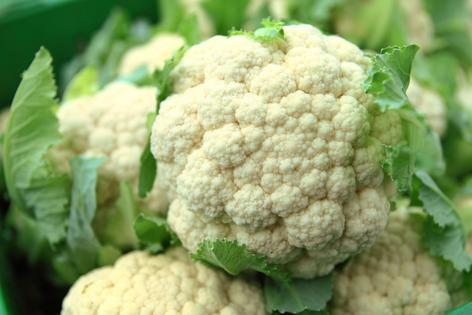Environmental Nutrition: Calling out cauliflower
Delicious on its own, cauliflower's unassuming flavor happily adapts to many culinary profiles, from curried to pickled, making it so easy to enjoy its bounty of health and nutrition benefits.
The folklore. Cauliflower's "brainy" appearance clearly suggests it's a smart dietary choice. Its name comes from the Latin words caulis, which means cabbage, and floris, or flower. Indeed, cauliflower shares its history with the cabbage, traced back to 6,000 B.C., when the Roman philosopher, Pliny the Elder, deemed cauliflower the most pleasant tasting variety of cabbage in his encyclopedia, Natural History.
The facts. Cauliflower (Brassica oleracea) is part of the very recognizable vegetable family known as crucifer, or Brassica, which includes cabbage, broccoli, kale and collard greens. Cauliflower has a closely packed "head" of undeveloped flower buds surrounded by green leaves that shelter it from the sun, preventing the formation of chlorophyll in white varieties. There are also green (Broccoflower), purple and orange (sometimes called "cheddar") varieties. A one-cup serving has just 28 calories, yet packs an impressive 92 percent DV (Daily Value, based on 2,000 calories/day) of antioxidant vitamin C, 22 percent DV of vitamin K for healthy blood function, as well as several beneficial sulfur-containing compounds called glucosinolates.
The findings. Scientists recommend consumption of Brassicas, including cauliflower, largely because they are rich sources of glucosinolates. When eaten, glucosinolates form isothiocyanates, which are linked to cancer prevention (Frontiers in Plant Science, 2017). Sulforaphane, another type of isothiocyanate present in Brassicas, has shown antitumor effects and inhibition of cancer cell growth, which become even more potent when combined with irradiation treatment (PLoS One, 2017). Glucosinolates in Brassicas also have been found to benefit cardiovascular health by significantly reducing blood cholesterol levels (Molecular Nutrition & Food Research, 2015).
The finer points. Peak season runs September through November, but cauliflower's popularity merits year round availability. The freshest cauliflower has a pristinely white (or green, purple, or orange!), tightly packed head that's free of spots or blemishes, and is wrapped in healthy looking green leaves. Store, refrigerated, up to a week in a plastic bag. Minimize cooking time to maintain its health promoting compounds, while exploring this veggie's versatility: Slice into "steaks," chop and saute or roast, process into "rice," or puree into mashed "potatoes" for fun twists on the ordinary.
Cauliflower Almond Soup
Serves 4
1 medium onion, diced
4 cloves garlic, minced
...continued







